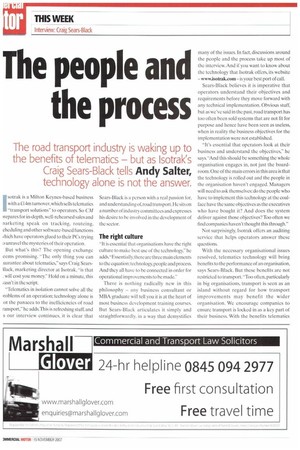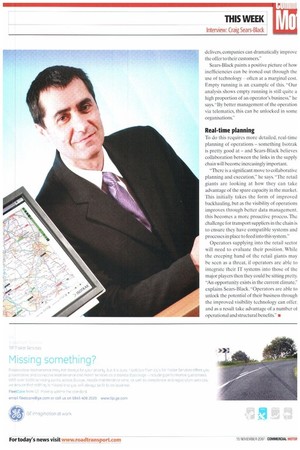The people and the process
Page 26

Page 27

If you've noticed an error in this article please click here to report it so we can fix it.
The road transport industry is waking up to
the benefits of telematics — but as Isotrak's Craig Sears-Black tells Andy Salter, technology alone is not the answer.
Isotrak is a Milton Keynes-based business with a .#114m turnover, which sells telematics -transport solutions" to operators, So CM irepares for in-depth, well-rehearsed sales and narketing speak on tracking, routeing, checluling and other software-based functions vhich have operators glued to their PCs trying a unravel the mysteries of their operation.
But what's this? The opening exchange eems promising. "The only thing you can ,uarantee about telematics," says Craig Searsflack, marketing director at Isotrak. is that . will cost you money." Hold on a minute, this vasn't in the script.
"Telernatics in isolation cannot solve all the ,roblems of an operation; technology alone is ot the panacea to the inefficiencies of road ransport," he adds. This is refreshing stuff, and s our interview continues, it is clear that Sears-Black is a person with a real passion for, and understanding of, road transport. He sits on a number of industry committees and expresses his desire to be involved in the development of the sector.
The right culture
It is essential that organisations have the right culture to make best use of the technology," he adds."Essentially, there are three main elements to the equation: technology, people and process. And they all have to be connected in order for operational improvements to be made."
There is nothing radically new in this philosophy — any business consultant or MBA graduate will tell you it is at the heart of most business development training courses. But Sears-Black articulates it simply and straightforwardly. in a way that demystifies many of the issues. In fact, discussions around the people and the process take up most of the interview. And if you want to know about the technology that Isotrak offers, its website — www.isotrak.com — is your best port of call.
Sears-Black believes it is imperative that operators understand their objectives and requirements before they move forward with any technical implementation. Obvious stuff, but as we've said in the past, road transport has too often been sold systems that are not fit for purpose and hence have been seen as useless, when in reality the business objectives for the implementation were not established.
"It's essential that operators look at their business and understand the objectives," he says. And this should be something the whole organisation engages in, not just the boardroom. One of the main errors in this area is that the technology is rolled out and the people in the organisation haven't engaged. Managers will need to ask themselves: do the people who have to implement this technology at the coalface have the same objectives as the executives who have bought it? And does the system deliver against those objectives? Too often we find companies haven't thought this through."
Not surprisingly, Isotrak offers an auditing service that helps operators answer these questions.
With the necessary organisational issues resolved, telematics technology will bring benefits to the performance of an organisation, says Sears-Black. But these benefits are not restricted to transport. "Too often, particularly in big organisations, transport is seen as an island without regard for how transport improvements may benefit the wider organisation. We encourage companies to ensure transport is locked in as a key part of their business. With the benefits telematics delivers, companies can dramatically improve the offer to their customers," Sears-Black paints a positive picture of how inefficiencies can be ironed out through the use of technology often at a marginal cost. Empty running is an example of this. -Our analysis shows empty running is still quite a high proportion of an operator's business," he says. "By better management of the operation via telematics, this can be unlocked in sonic organisations."
Real-time planning To do this requires more detailed, real-time planning of operations something Isotrak is pretty good at and Sears-Black believes collaboration between the links in the supply chain will become increasingly important.
"There is a significant move to collaborative planning and execution," he says. -The retail giants are looking at how they can take advantage of the spare capacity in the market. This initially takes the form of improved backhauling, but as the visibility of operations improves through better data management, this becomes a more proactive process. The challenge for transport suppliers in the chain is to ensure they have compatible systems and processes in place to feed into this system."
Operators supplying into the retail sector will need to evaluate their position. While the creeping hand of the retail giants may he seen as a threat, if operators are able to integrate their IT systems into those of the major players then they could be sitting pretty. 'An opportunity exists in the current climate,' explains Sears-Black. "Operators are able to unlock the potential of their business through the improved visibility technology can offer. and as a result take advantage of a number of operational and structural benefits." •


























































































































































































